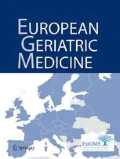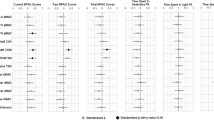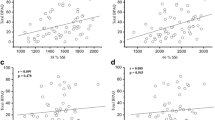Key summary points
To determine the prevalence and risk factors for osteoporosis in persons over 65 who live in nursing homes.
AbstractSection FindingsThe prevalence of osteoporosis among residents in nursing homes, based on QUS bone measurements and defined as QUI-T score ≤ − 2.2, was 51.9% in women and 8.5% in men. Physical activity was a more important factor for preserving bone health than calcium intake.
AbstractSection MessageRegular screening for osteoporosis, together with nutrition assessment and physical activity promotion, should be implemented in nursing home settings.
Abstract
Purpose
Low bone mineral density has been reported in institutionalized old people, but limited data are available on the association between bone density and physical activity (PA) and calcium intake in that population. We explored the predictors of bone density in old people living in nursing homes, focusing on PA and calcium intake.
Methods
In a cross-sectional study, we measured bone density with quantitative ultrasound (QUS) in 292 nursing homes residents (233 women and 59 men), mean age 82.4 ± 6.5 years. Information on lifestyle habits and calcium intake was obtained with questionnaires.
Results
All QUS bone parameters were significantly higher in men than in women (p < 0.001). A T score for quantitative ultrasound index (QUI) of − 2.2 or lower was found in 8.5% of men and 51.9% of women. Participants of both genders with low PA had a significantly lower QUI, QUI-T score compared to those with good/very good PA. When controlling for age, gender, body mass index and calcium intake, participants with good PA had better QUI than those with low PA (β = 7.12 with 95% CI [2.51, 11.74]) The odds of QUI-T score < − 2.2 were lower (OR 0.49 with 95% CI [0.27, 0.90]) in participants with good PA compared to those with low PA.
Conclusions
The prevalence of osteoporosis measured by QUS was high in women but not in men. In our study sample, PA played a more important role than calcium intake in preserving bone density in old people.
Similar content being viewed by others
References
Johnell O, Kanis JA (2006) An estimate of the worldwide prevalence and disability associated with osteoporotic fractures. Osteoporos Int 17:1726–1733
Duque G, Lord SR, Mak J, Ganda K, Close JJT, Ebeling P, Papaioannou A, Inderjeeth CA (2016) Treatment of osteoporosis in Australian residential aged care facilities: update on consensus recommendations for fracture prevention. J Am Med Dir Assoc 17:852–859
US Preventive Services Task Force (2018) Screening for osteoporosis to prevent fractures US preventive services task force recommendation statement. JAMA 319:2521–2531
Wuster C, de Terlizzi F, Becker S, Cadossi M, Cadossi R, Muller R (2005) Usefulness of quantitative ultrasound in evaluating structural and mechanical properties of bone: comparison of ultrasound, dual-energy X-ray absorptiometry, micro-computed tomography, and mechanical testing of human phalanges in vitro. Technol Health Care 13:497–510
Knapp KM (2009) Quantitative ultrasound and bone health. Salud Publica Mex 51(suppl 1):S18–S24
Gudmundsdottir SL, Indridason OS, Franzson L, Sigurdsson G (2005) Age-related decline in bone mass measured by dual-energy x-ray absorptiometry and quantitative ultrasound in a population-based sample of both sexes. J Clin Densitom 8:80–86
Ding Z, Chen Y, Xu Y, Zhou X, Xu Y, Ma Z, Sun Y (2018) Impact of age, gender, and body composition on bone quality in an adult population from the middle areas of China. J Clin Densitom 21:83–90
Crogan NL, Alvine C, Pasvogel A (2006) Improving nutrition care for nursing home residents using the INRx process. J Nutr Elder 25:89–103
Suominen MH, Hosia-Randell HM, Muurinen S, Peiponen A, Routasalo P, Soini H, Suur-Uski I, Pitkala KH (2007) Vitamin D and calcium supplementation among aged residents in nursing homes. J Nutr Health Aging 11:433–437
Curtain CM, Williams M, Cousins JM, Peterson GM, Winzenberg T (2016) Vitamin D and calcium supplementation among aged residents in nursing homes. Drugs Aging 33:747–754
Smith RL (2003) Calcium and vitamin D supplementation in nursing home residents. JAMDA 4(suppl):S1–S88
Assantachai P, Angkamat W, Pongpim P, Weattayasuthum C, Komoltri C (2006) Risk factors of osteoporosis in institutionalized older Thai people. Osteoporos Int 17:1096–1102
Dionyssiotis Y, Paspati I, Trovas G, Galanos A, Lyritis GP (2010) Association of physical exercise and calcium intake with bone mass measured by quantitative ultrasound. BMC Women’s Health 10:12
Chandler JM, Zimmerman SI, Girman CJ, Martin AR, Hawkes W, Hebel JR, Sloane PD (2000) Low bone mineral density and risk of fracture in white female nursing home residents. JAMA 284:972–977
Morrison A, Fan T, Sen SS, Weisenfluh L (2013) Epidemiology of falls and osteoporotic fractures: a systematic review. Clinicoecon Outcomes Res 5:9–18
Sun F, Norman IJ, While AE (2013) Physical activity in older people: a systematic review. BMC Public Health 13:449
Satalic Z, Colic Baric I, Cecic I, Keser I (2007) Short food frequency questionnaire can discriminate inadequate and adequate calcium intake in Croatian postmenopausal women. Nutr Res 27:542–547
Kaić-Rak A, Antonic K (1990) Food composition tables. Croatian Institute of Public Health, Zagreb
Kraljevic I, Kastelan D, Kolcic I, Kardum I, Mazalin-Protulipac J, Korsic M (2007) Calcaneal ultrasound parameters in men and women from central Croatia. Med Sci Monit 13:29–33
World Health Organization (1994 ) Assessment of fracture risk and its application to screening for postmenopausal osteoporosis. Report of a WHO Study Group. Geneva (WHO Technical Report Series, No. 843)
Hans D, Hartl F, Krieg MA (2003) Device-specific weighted T-score for two quantitative ultrasounds: operational propositions for the management of osteoporosis for 65 years and older women in Switzerland. Osteoporos Int 14:251–258
Firth D (1993) Bias reduction of maximum likelihood estimates. Biometrika 80:27–38
R Core Team (2017 R: a language and environment for statistical computing. R Foundation for Statistical Computing, Vienna, Austria. https://www.R-project.org/
Cvijetic S, Pavlovic M, Pasalic D, Dodig S (2011) Ultrasound bone measurement in an older population with metabolic syndrome. Aging Clin Exp Res 23:29–34
Maggi S, Noale M, Giannini S, Adami S, Defeo D, Isaia G, Sinigaglia L, Filipponi P, Crepaldi G, ESOPO Study Group (2005) Quantitative heel ultrasound in a population-based study in Italy and its relationship with fracture history: the ESOPO study. Osteoporos Int 17:237–244
Ou LC, Sun ZJ, Chang YF, Chang CS, Chao TH, Kuo PH, Lin RM, Wu CH (2013) Epidemiological survey of quantitative ultrasound in risk assessment of falls in middle-aged and elderly people. PLoS ONE 8:e71053
de Oliveira PP, Figueiredo Marinheiro IP, Osório Wender MC, Bossoni Mendes J, Oisenberg F (2011) Quantitative ultrasound and risk of fractures in elderly women. Rev Assoc Med Bras 57:637–642
Ekman A, Michaelsson K, Ljunghall S, Mallmin H (2001) Almost all institutionalized women are osteoporotic, when measured by heel and finger ultrasound. J Int Med 249:173–180
Elliott ME, Binkley NC, Carnes M, Zimmerman DR, Petersen K, Knapp K, Behlke JM, Ahmann N, Kieser MA (2003) Fracture risks for women in long-term care: high prevalence of calcaneal osteoporosis and hypovitaminosis D. Pharmacotherapy 23:702–710
Greenspan SL, Myers ER, Kiel DP, Parker RA, Hayes WC, Resnick NM (1998) Fall direction, bone mineral density, and function: risk factors for hip fracture in frail nursing home elderly. Am J Med 104:539–545
Sallin U, Mellström D (2005) Eggertsen R. Osteoporosis in a nursing home, determined by the DEXA technique. Med Sci Monit 11:CR31-70
Hess M, Campagna EJ, Jensen KM (2018) Low bone mineral density risk factors and testing patterns in institutionalized adults with intellectual and developmental disabilities. J Appl Res Intellect Disabil 31(Suppl. 1):157–164
Vive MA, Nahar VK, Ford MA, Bass MA, Johnson AK, Davis AB, Biviji-Sharma R (2015) Risk factors for low bone mineral density in institutionalized individuals with developmental disabilities. Health Promot Perspect 5:147–152
Almeida P, Neves R (2014) Physical activity—the attitude of the institutionalized elderly. JPES 14:12–15
Rydwik E, Kerstin F, Akner G (2005) Physical training in institutionalized elderly people with multiple diagnoses—a controlled pilot study. Arch Gerontol GeriatR 40:29–44
Liubicich ME, Magistro D, Candela F, Rabaglietti E, Ciairano S (2012) PA and mobility function in elderly people living in residential care facilities. “Act on aging”: a pilot study. Adv Phys Educ 2:54–60
Reginster JY, Beaudart C, Buckinxa F, Bruyère O (2016) Osteoporosis and sarcopenia: Two diseases or one? Curr Opin Clin Nutr Metab Care 19:31–36
Santos L, Elliott-Sale KJ, Sale C (2017) Exercise and bone health across the lifespan. Biogerontology 18:931–946
Marques EA, Mota J, Carvalho J (2012) Exercise effects on bone mineral density in older adults: a meta-analysis of randomized controlled trials. Age(Dordr) 34:1493–1515
McMillan L, Zengin A, Ebeling P, Scott D (2017) Prescribing PA for the prevention and treatment of osteoporosis in older adults. Healthcare 5:E85
Maddalozzo G, Snow C (2000) High intensity resistance training: effects on bone in older men and women. Calcif Tissue Int 66:399–404
Rumbak I, Satalić Z, Keser I, Krbavcić IP, Giljević Z, Zadro Z, Barić IC (2010) Diet quality in elderly nursing home residents evaluated by Diet Quality Index Revised (DQI-R). Coll Antropol 34:577–585
Nguyen TV, Center JR, Eisman JA (2000) Osteoporosis in elderly men and women: effects of dietary calcium, PA, and body mass index. J Bone Min Res 15:322–331
Vannucci L, Masi L, Gronchi G, Fossi C, Carossino AM, Brandi ML (2017) Calcium intake, bone mineral density, and fragility fractures: evidence from an Italian outpatient population. Arch Osteoporos 12:40
Chapuy MC, Pamphile R, Paris E, Kempf C, Schlichting M, Arnaud S, Garnero P, Meunier PJ (2002) Combined calcium and vitamin D3 supplementation in elderly women: confirmation of reversal of secondary hyperparathyroidism and hip fracture risk: the Decalyos II study. Osteoporos Int 13:257–264
Acknowledgements
The authors thank the residents and personnel of the nursing homes: Centar, Ksaver, Maksimir, Park, Sveti Josip and Tresnjevka for their participation, help and support.
Funding
The study was supported by the Institute for Medical Research and Occupational Health (Project “Bone mineral density and fracture risk in older institutionalized people”).
Author information
Authors and Affiliations
Corresponding author
Ethics declarations
Conflict of interest
On behalf of all authors, the corresponding author states that there is no conflict of interest.
Ethical approval
The study was designed in accordance with the 1964 Helsinki Declaration and its later amendments or comparable ethical standards and was approved by the Ethics Committee of the Institute of Medical Research and Occupational Health.
Informed consent
Informed consent was obtained from all individuals included in the study.
Additional information
Publisher's Note
Springer Nature remains neutral with regard to jurisdictional claims in published maps and institutional affiliations.
Rights and permissions
About this article
Cite this article
Cvijetic, S., Kovacic, J. Association between quantitative bone ultrasound and self-reported physical activity in nursing homes residents. Eur Geriatr Med 10, 659–666 (2019). https://doi.org/10.1007/s41999-019-00183-3
Received:
Accepted:
Published:
Issue Date:
DOI: https://doi.org/10.1007/s41999-019-00183-3




